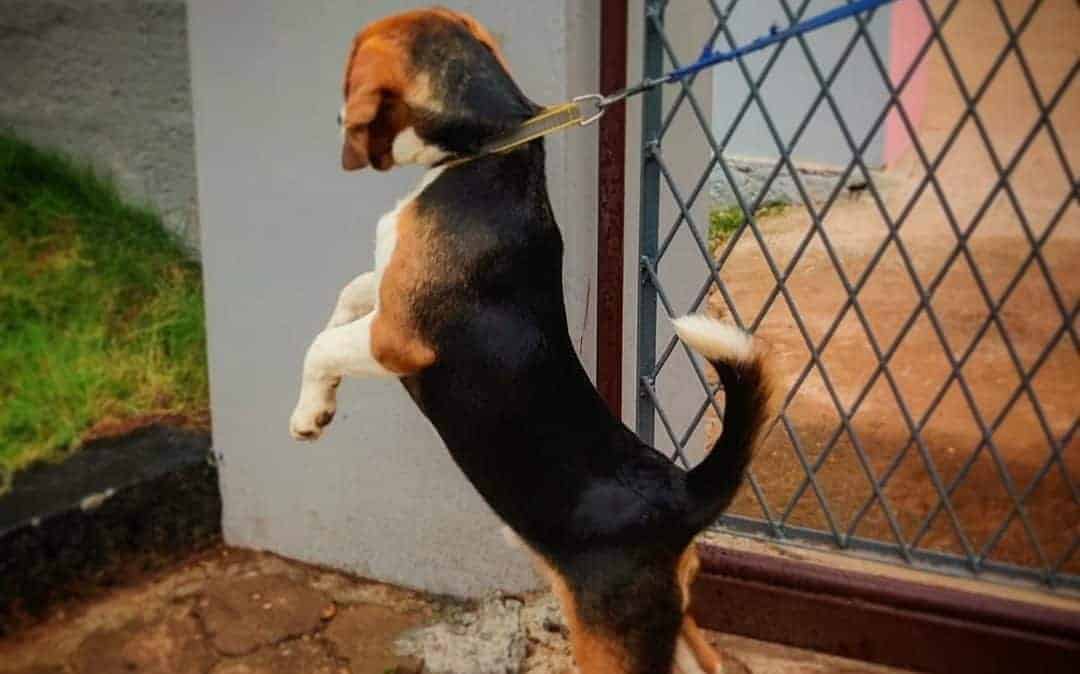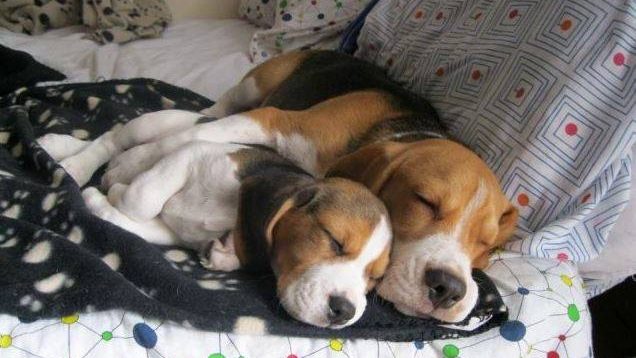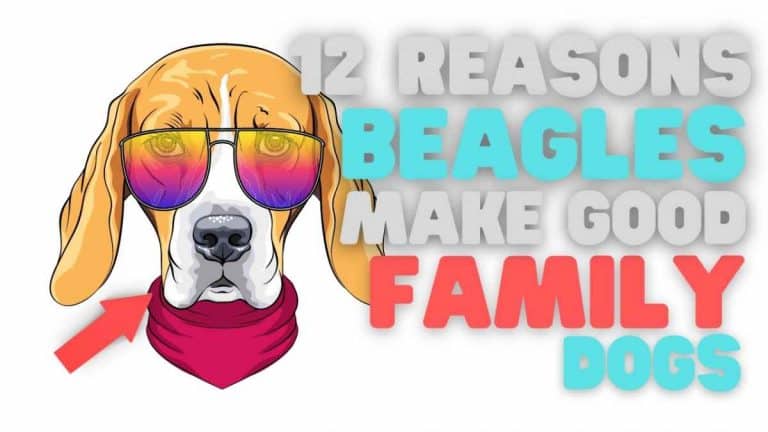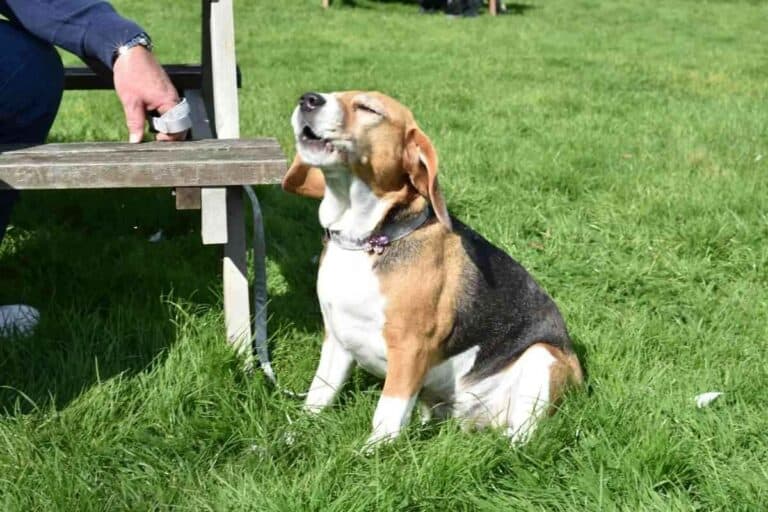How to Stop Your Beagle From Pulling on the Leash (Solved!)
If you have a Beagle, you know how stubborn they can be when it comes to leash training.
When my Beagle was a puppy, he didn’t know very much, and walking with a leash didn’t come naturally to him. He had to learn how to walk with me on a leash.
At first, all he did is pull on the leash. It was frustrating. Once I learned what to do, I taught him how to walk on a leash without pulling.
It took a few weeks of consistent training, but he learned how to do it stuck with him into his adult life.
How to Stop a Beagle from Pulling on a Leash
- Step 1: Use the correct type of collar (see below)
- Step 2: Adjust collar to upper neck behind his ears
- Step 3: Stop walking & gently tug on the leash when your Beagle pulls
- Step 4: Use positive reinforcement & reward your Beagling when he stops
- Step 5: Use a leash to guide him where you want him to go
Beagles will stop pulling the leash when properly trained on how to walk with a human on a leash.
These are just the basic steps. We’ll get into the details below.
Leash Training is Important For Beagles
Beagles are hound dogs and have an incredible sense of smell. More so than non-hound breeds. They are bred to be able to track scents.
Smells can overwhelm them, and when they get on a trail, they can lose track of everything else, training and obeying commands can go right out the window—even the best trained Beagles.
Being on a leash is a requirement for a Beagle. As Beagle owners, it’s our job to keep them safe from themselves and wandering off.
Why do Beagles pull on the leash?
Beagles will pull on the leash when they are excited and want something they see or smell. Beagles will pull on the leash, especially as puppies when they lack the proper leash training. If your Beagle pulls on the leash, he needs to be trained to walk with a leash properly.
How to Stop a Beagle from Pulling on a Leash
Step One: Choose The Right Collar
There are three categories of collars. If you want to train your beagle to walk with you on a lead, you need the right equipment to properly train him. Investing in the right tools for the job will go a long way.
Stop Using These Collars:

- Flat Collars
- Flat collars are the most basic and most common dog collars.
- The problem with them is that they can encourage your dog to pull.
- It sits comfortably on his neck and doesn’t provide discomfort when your dog pulls.
- They can be slipped out of easily.
- It should be avoided until the Beagle is trained to walk with a leash.
- Dog Harnesses
- Encourage Beagles to pull even more than flat collars do
- Harnesses should be avoided for Beagles.
- They wrap over your Beagle’s body and cross around his chest area. Harnesses can make your dog feel secure, which encourages pulling.
- They are positioned in an area that makes it easier for him to pull heavy objects behind him.
- Think of a working dog that has to pull a sled. A harness makes it easier for him.
Use These Collars
- No-Pull Dog Collars
- These collars slip over your Beagle’s neck, and when your beagle pulls, the collar tightens and applies pressure to his neck.
- They must be put on correctly and places on the upper neck behind the ears.
- When they pull, it creates pressure that is safe but still uncomfortable.
- Not to be used on its own but when combined with consistent training.
- They make cloth-based no-pull dog collars.
- There are also metal chokers, but I don’t think they are needed for most beagles.
- Can transition to a regular collar when trained, but some Beagles may do better with these permanently.
- Slip-Rope dog training leads
- These are rope-based slip notes that go over your dog’s neck and offer enough length to be used as a leash.
- Uses pressure around the neck to make it difficult and uncomfortable for your dog to pull
- To be used in combination with consistent training, not on its own.
- Slip Rope Leash/Collar Combo
- Used for training
- Helps to begin with this before transitioning to a flat collar
- No-Pull Dog Harness
- These are harness that prevents your dog from being able to pull.
- Different types to choose from
- More comfortable and safer than slip-ropes & chokers
- They create a tight fit around the dog’s chest in the area where his legs begin.
- This makes it hard for him to pull.
- He will move with you instead of lead you.
- This can help train a Beagle not to pull.
- Temporary in most cases until training is sufficient.
Step Two: Fitting the Collar
Once you have a suitable collar or harness, you will have to size it correctly.
- The instructions will vary based on the type of collar and brand you choose.
- Follow instructions and make sure you have a secure fit.
Step Three: Teaching Your Beagle To Stop Pulling

Now that his collar is fitted correctly, it’s time to take your Beagle for a walk. Walk as usual until he starts to pull.
- Each time he begins to pull, stop walking, and standstill.
- Tug gently on the leash, pulling it back towards you and not up
- Do this each time your Beagle starts to pull.
- If you arent walking, then your Beagle shouldn’t be walking.
- Be consistent and disciplined with this.
Step Four: Rewarding Your Beagle For Obeying
- Each time your Beagle stops when you stop rewarding him with a treat.
- It also helps to use a clicker or to pick command to say that will let your dog know that you approve of what he is doing.
- This is a form of positive reinforcement.
- You want to reinforce good behavior with positive things like treats and praise.

Step Five: Guiding a Beagle With a Leash
Once your Beagle understands that you aren’t going to allow him to pull, the next step is teaching him to follow your lead.
You want him to go wherever you lead him.
- You will lead him by gently tugging on the leash. Once your Beagle is trained, he will associate a change in direction with the side you tug him on.
- If you are walking him and he’s walking with you successfully, then you want to tug left if you want him to go left or you are about to make a turn.
- This signals to him what’s expected.
- You should reward him with treats each time he successfully turns in the direction you want him to.
3 Tips To Get Your Beagle To Stop Pulling on the Leash

Tip #1 Immersion Training
If you want your Beagle to learn how to stop pulling, then he needs to practice walking on a lead with you consistently.
It’s easy to become frustrated when you want your Beagle to walk with you, and he doesn’t. I know from experience but patience and consistency will go a long way.
Going on walks multiple times per day, every day, for a few weeks, will ensure that your Beagle can learn quickly.
The more you walk him and apply the training tips mentioned, the faster you will see results.
The speed depends on a large part on you. I think immersion learning is the best.
If your Beagle has experienced multiple times per day, every day, training him to stop pulling shouldn’t take more than a few weeks.
I know because my Beagle used to pull, and this is what I did with him.
Tip #2 Bring Treats With You
By now, you should know that the fastest way to a Beagle’s heart is through his stomach, by giving him food.
Beagles have such a strong sense of smell that makes food irresistible to them. They will do just about anything you want them to do if food is involved.
Use their favorite treat as a reward for when they obey you and do something pleasing to you. This will wire them to associate the positive behavior with treats.
Once your Beagle progresses, you can minimize the number of treats you give him, but it’s always helpful to keep some on hand.
Tip #3 Train Them When They’re Puppies
This is probably obvious, but puppies are much easier to train than adult dogs.
It’s not that adult dogs are hard to train. Still, they have experiences that have already formed personalities, habits, and fears.
In other words, adult Beagles are more set in their way and stubborn, just like adult humans can become as they age.
You can teach a dog new tricks, for sure. It’s very doable, but it requires more time and patience.
Train them while they’re young to avoid the headache
How I Got My Beagle To Stop Pulling on His Leash
When I first got my Beagle, he didn’t know how to walk on a leash at all. All he would do was bite the leash and try to play each time I tried to walk him.
He was in his own world and couldn’t understand what I was trying to teach him.
As a young puppy, I used treats to bribe him. It wasn’t too difficult to get him where I wanted him. Still, as he grew and got stronger, the treats lost some of their appeal, like new sights and smell became more attractive to him than the treats I had.
When he was a year old, I started using a No-Pull harness after unsuccessfully using a regular dog harness. I learned pretty quickly that the normal harnesses made things worse when he pulled.
The no-pull harness I got him fit snuggly under his upper legs. It made it so that if he tried to pull, it would automatically force his body to walk in the direction I was tugging.
It was uncomfortable for him at first, I could tell, but it definitely wasn’t painful.
I walked him multiple times per day during this time. It didn’t take my beagle long to learn how to stop pulling and walk with me. I went back and forth between his regular collar and the harness until after 3 months, he demonstrated a good training level.
I ditched the harness after a few months until he began pulling again. It was minimal. I think the first year or two, I used that harness several times.
It was always a good reminder to him to stop pulling.
I have not had to use it since he turned 2.

Final Thoughts
Anyway, I hoped you’ve learned something from my experience. If you’ve successfully stopped your Beagle from pulling on the leash, then please help the community out by sharing it in the comments section. It would be helpful to know what some of you have done.
-Andrew






